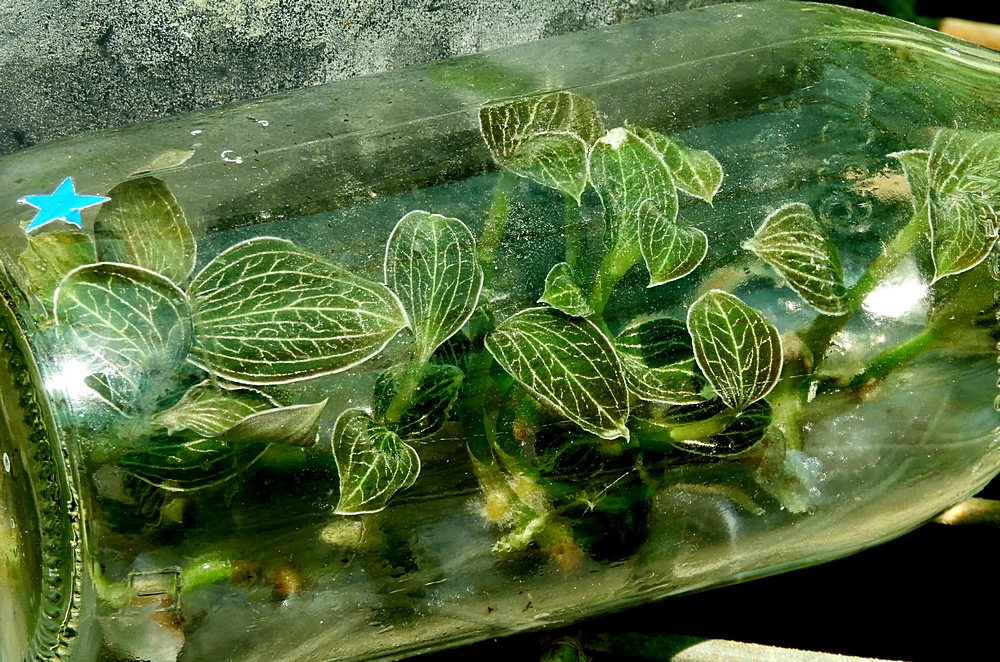|
|
|
CONTACT US
Click Here! |
| This site is best viewed with a screen resolution of 800 X 600 at high colour settings |
|
Flask list
Acacallis-Ancistrochilus Angraecum-Aspasia Barkeria-Broughtonia Bulbophyllum Capanemia-Catasetum Cattleya Cattleyopsis-Cycnoch, Cymbidium-Cyrtorchis Dendrobium-Dossinia Encyclia-Eulophiella Galeandra-Kalopternix Laelia-Lycaste Macodes-Nephalaphyll, Odontogloss,-Oncidium Paphiopedilum-Psychilis Rangaeris-Stenocoryne Tainia-Zygopetalum |
|
Plant list
Acampe-Bulbophyllum Cattleya-Dossinia Encyclia-Promeaea Renanthera-Vanda |

BP SPECIES NEWSLETTER July 2001
Right; Macodes lowii (illustration from L.Linden, L'Illustration Horticole), Photos in this issue: Nervilia discolor, Nervilia peltata, Habenaria ochroleuca.Do you know any orchid growers who may like to receive this newsletter? Why not forward this email to them now! Email www.speciesorchids.com and fill in the online form.Items in this newsletter may be reproduced provided source acknowledged.We commend "Orchids Online Web Design" for the excellent work on our web site and this Newsletter.For information or prices click here or email Steve at steve@orchidsonline.com........A. What's New in flask.B. What's ready to replate NOW.D. SUNDAY CREEK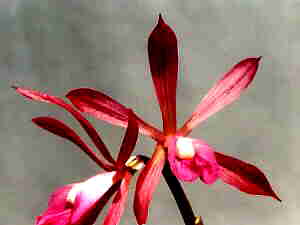
The creek, an unbroken canopied corridor through wet melaleuca flats and open eucalyptus forest, was host to a fascinating array of orchid species, inviting exploration. Under the canopy, on the top of the bank, a colony of Nervilia dallachyana, hugging the well drained slope of leafmould rich soil, glistened green and purple flushed green, beautiful heart shaped, veined leaves. Named after an early Queensland surveyor and pathfinder, his botanical immortality sadly lost with the reclassification of the species to Nervilia discolor, and then yet again to Nervilia plicata. Photo above left, below right Nervilia plicata. A short distance away, in the shade of a large eucalypt, on a small patch of bare 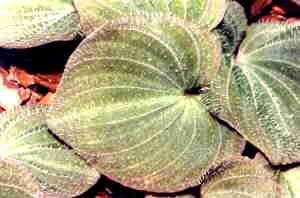 ground was our first exciting find. Looking more like little grey
green mushrooms, flat on the ground, barely an inch across, were the leaves of
a new Nervilia. There was about a dozen of them, carefully
counted on each subsequent visit in search of flowers which were never found.
ground was our first exciting find. Looking more like little grey
green mushrooms, flat on the ground, barely an inch across, were the leaves of
a new Nervilia. There was about a dozen of them, carefully
counted on each subsequent visit in search of flowers which were never found.
We speculated, perhaps this was the long lost Nervilia pachystomoides. Further out in the eucalypt forest, we did unknowingly find this lost species in the pure sparkling white flowers of Didymoplexis pallens, a saprophyte. Seen years later, a drawing of the holotype of Nervilia pachystomoides clearly showed its true identity as the Didymoplexis. A little gem, hiding in the grass tussocks. Squatting in the grass, debating the identity of Pachystoma holtzei; was this an orchid or merely a common look alike?, a plicate leafed, grass like plant. The buried tuber, distinctively shaped, like that of a thin drawn out Eulophia tuber, confirmed its identity. The flowers came later, pale pink green, the lip with a green yellow disc. 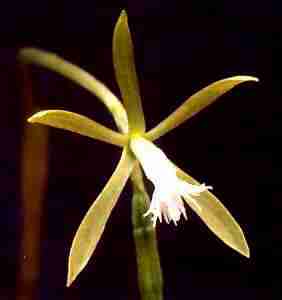
Out of the forest, into the wet melaleuca flat, the ground soggy, the habitat of Habenarias anomala, ferdinandii and ochroleuca and one or two other species, their green white plume spikes scattered through the grass beneath the teatrees. The teatrees held Dendrobium canaliculatum, and button orchids, really a Distidia, and ant plants with aggressive inhabitANTS. There too grew an unidentified Calochilus, smaller than the Calochilus holtzei, also with beautiful metallic coloured flowers. Back into the shade of the creek's canopy, growing at the bottom of the bank, was another exciting find in large leafy plants of Habenaria sumatrana, its tiny pure white flowers, with a distinctive 3 lobed lip, borne on foot high spikes. A long way from its holotype location in Sumatra, but wide spread throughout Indonesia, Malaysia, New Guinea and there blooming in a shady creek in Queensland. Sharing its habitat, thin wiry plants of Apostasia stylidioides produced tiny yellow flowers, not orchid like at all. The track was overgrown, disappearing, and as I followed long ago footsteps, the present bought a scenery of change. 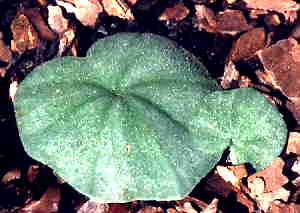
Gone was the unbroken canopy, raggedly cut by power lines and towers, rough roads bulldozed over the creek, to make way for cattle and tractor slashers. Gone was the colony of Nervillia discolor, a road gutter in its place. Gone the treasured grey green mushroom Nervillia, a bush tractor shed and oil drums in its place. Gone were the Calochilus and Pachystoma and Spiculea, a slashed field for cattle left behind. Gone were the Habenarias, Dendrobiums, and the melaleuca flat, a pine plantation instead. Gone were the Habenaria sumatrana, its shelter destroyed, and cattle left to tread the banks into eroded paths. Only the Apostasia somehow maintained a hold in the shelter of some Lantana shrub. A second colony of little grey green mushroom Nervilias, (Photo above left, and right, N.peltata), found years after the first, captured on an island between the old highway and the new, deprived of the periodic fire burn off, covered and smothered with leafmould and debris, deprived of sunlight, gone. Only the saprophtic Didymoplexis found the leafmould and debris a rich boon, having no leaves in need of sunlight, their elegant white flowers rising above the carpet of leaves. A third colony of the grey green mushroom Nervilia, (recently named Nervilia peltata) still exists, precariously 6 inches from a 4wheeldrive fisherman’s track, about a dozen little plants growing on the edge of destruction. 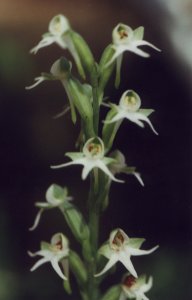
Photographs and text by Ian Walters, Burleigh Park Orchid Nursery, 54 Hammond Way, Thuringowa, Queensland. Australia.4815. Names of species may have changed with progress and botanists’ views, but these were the species we found and their names at the time. For more photos www.speciesorchids.com Photo right Habenaria ochroleuca
E. Web page.".......and what are your job prospects, son ?" Boy: "I hope to study the Bible and religion" Father: "...and will that be enough to support a wife" Boy: "The Lord will provide" Father: "...and will you be able to support a wife and children if that eventuates?" Boy: "The Lord will provide" Father, discussing this with his wife. Wife: "What did you make of our future son in law?" Father: "Well, the bad news is he does not have much prospects in the way of a job and a living, but the goods news is, he thinks I'm God." On a maiden a man once begat, A woman went to the post office to buy stamps for her Christmas
cards. G. Subscribe or Unsubscribe |
Designed and maintained by
Orchids Online Web Design
© All rights reserved.
